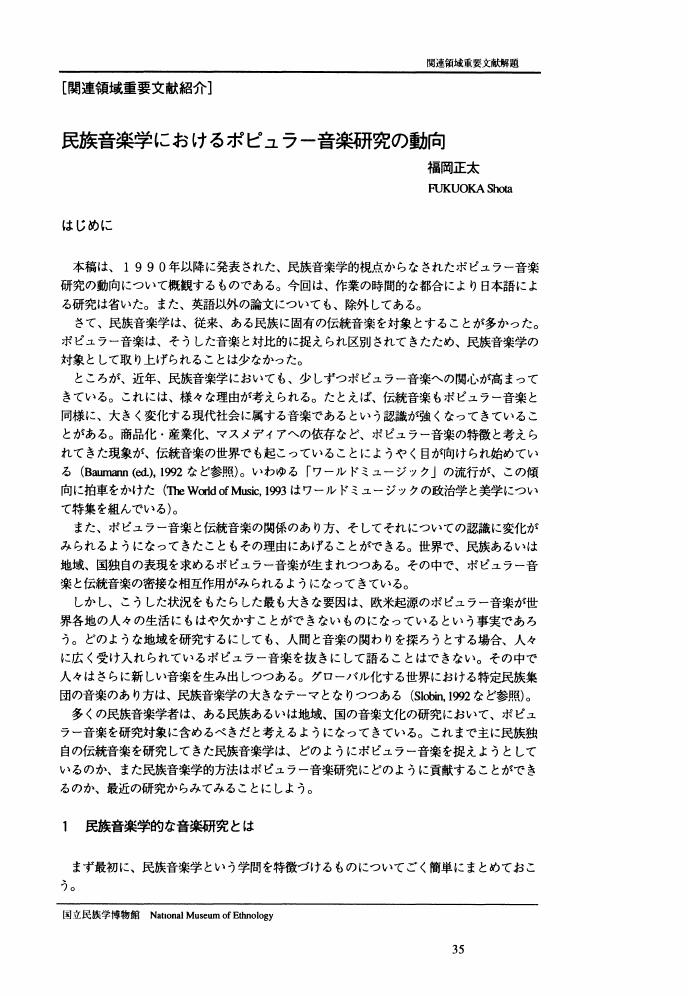2 0 0 0 OA 小泉文夫の日本伝統音楽研究 ―民族音楽学研究の出発点として―
- 著者
- 福岡 正太 Fukuoka Shota フクオカ ショウタ
- 出版者
- 国立民族学博物館
- 雑誌
- 国立民族学博物館研究報告 (ISSN:0385180X)
- 巻号頁・発行日
- vol.28, pp.257-295, 2003-10-31
2 0 0 0 IR 小泉文夫の日本伝統音楽研究--民族音楽学研究の出発点として
- 著者
- 福岡 正太
- 出版者
- 国立民族学博物館
- 雑誌
- 国立民族学博物館研究報告 (ISSN:0385180X)
- 巻号頁・発行日
- vol.28, no.2, pp.257-295, 2003
小泉文夫(1927–1983)は,日本における民族音楽学研究のパイオニアとして知られている。彼の最初の代表的研究成果『日本伝統音楽の研究』(1958)は,日本の民謡を研究対象としてその音階構造を明らかにした。この論文は,小泉の日本伝統音楽研究を支えた基本的な考え方を検討し,彼の民族音楽学研究の出発点と特徴を明らかにすることを目的としている。 小泉が音楽研究を志した敗戦直後の日本社会において,多くの知識人が邦楽を封建的,非合理的,低俗なものとしていた。それを最もよく象徴したのが,1949 年,東京音楽学校が東京美術学校と統合され東京芸術大学として発足するときに邦楽科を廃止しようとした案だった。当時の東京音楽学校校長の小宮豊隆は,邦楽は新しい日本音楽創造の基礎とはなりえないとした。それに対して,日本音楽研究者である吉川英史は,邦楽にも洋楽に劣らない独自の価値があると論じ,邦楽科設置を訴えた。結局,東京芸術大学には邦楽科が設置されることになったが,復興をめざす日本社会における邦楽の存在価値をめぐる議論は,吉川を通じて小泉に大きな影響を与えた。 小泉は,洋楽を愛好していたが,東京大学で吉川の講義を受け,日本伝統音楽の研究に取り組み始めた。しかし,小泉が対象として取り上げたのは,吉川があまり関心を払わなかったわらべ歌をはじめとする民俗音楽だった。小泉は,民俗音楽は日本音楽の基層文化,すなわち個別性の強い邦楽の諸ジャンルの共通の基礎にある日本人の基本的音感を体現するものと捉えた。その研究方法として小泉がとったのは比較音楽学の方法である。彼は,音楽の研究を歌詞の文学的内容で置き換える従来の内容主義を退けて,主としてヨーロッパの音楽理論の立場において,音組織の「客観的な」認識を目指した。それは日本の伝統音楽を「音楽」として統一的に把握したいという態度の表れでもあった。小泉は,さらに,洋楽と邦楽の2 項対立をこえるために,第3 の視点として世界のさまざまな音楽との比較によりそれぞれを相対化して捉えることを目指していった。 その後,欧米の比較音楽学は民族音楽学へと展開し,それぞれの文化の中で音楽をとらえる方向へと研究の重点が移行していったのに対して,小泉は,世界のさまざまな音楽を調査し,比較しながら研究するという態度を基本的に維持した。そこには,日本の伝統音楽は日本人の民族性を反映している考えながらも,音楽という共通の枠組みの中で,相互に理解可能なものとしてとらえようとした小泉の基本的な態度が反映しているのだろう。Fumio Koizumi (1927–1983) is known for pioneering ethnomusicologyin Japan. His first book Nihon Dento Ongaku no Kenkyu (A Study on JapaneseTraditional Music, 1958) is one of his most important research outcomeswhich throw light on the basic scale structure of Japanese traditional music.This paper aims to examine his approach to Japanese traditional music andargues that it characterizes his ethnomusicological research afterwards.When Koizumi decided to pursue a career as a musicologist just afterthe end of the Second World War, many Japanese intellectuals evaluated Japanesetraditional music as "feudal", "irrational", or "vulgar". Demonstratingthis was a plan to eliminate the department of Japanese traditional music fromthe Tokyo National University of Fine Arts and Music when it was foundedby uniting the Tokyo Academy of Music and Tokyo Academy of Arts in1949. Toyotaka Komiya, then the director of Tokyo Academy of Music saidJapanese traditional music could not be a basis for the creation of New Japanesemusic. Eishi Kikkawa, a researcher of Japanese music, argued that Japanesetraditional music had a peculiar value not inferior to Western music andinsisted on the establishment of the department. At last, they established thedepartment based on a resolution of the Diet. The discussion about the significanceof Japanese traditional music in the process of postwar rehabilitationinfluenced Koizumi.Koizumi, who had a liking for Western music from his childhood, beganto take an interest in Japanese traditional music after attending lectures givenby Kikkawa at Tokyo University. Koizumi chose Japanese folk music includingchildren's songs as his object of research, to which Kikkawa did not pay muchattention. Koizumi thought folk music embodied a fundamental layer of Japanesemusic, or the basic musicality of the Japanese which underlay many differentgenres of traditional music. He studied it with a method of comparativemusicology. He denied the then common approach which replaced the studyof music with that of its literary content and aimed for "objective" recognitionof its tone system. This reflected his desire to grasp many different genres asbelonging to the same category of "music". Furthermore, in order to overcomethe dichotomy between Western and Japanese music, he intended to take a thirdperspective by comparing them with other music from around the world.While the name of comparative musicology was replaced by ethnomusicologyin Western Europe and North America during the 1950's and researcherscame to emphasize the study of music in culture, Koizumi kept his basicmethod of studying music by comparing various kinds of music of the world.On the one hand he assumed Japanese traditional music reflects national characteristicsof the Japanese, on the other hand he believed we could understanddifferent kinds of music of the world on a common ground of "music". Thisattitude had continued to characterize his ethnomusicological research.
- 著者
- 福岡 正太
- 出版者
- 日本音楽学会
- 雑誌
- 音楽学 (ISSN:00302597)
- 巻号頁・発行日
- vol.63, no.1, pp.38-40, 2017 (Released:2018-10-15)
1 0 0 0 OA 民族音楽学におけるポピュラー音楽研究の動向
- 著者
- 福岡 正太
- 出版者
- 日本ポピュラー音楽学会
- 雑誌
- ポピュラー音楽研究 (ISSN:13439251)
- 巻号頁・発行日
- vol.1, pp.35-43, 1997-11-30 (Released:2009-10-29)
- 参考文献数
- 53
- 被引用文献数
- 1
- 著者
- 藤井 知昭 嘉原 優子 寺田 吉孝 鈴木 道子 高橋 昭弘 樋口 昭 TOーNGOC Than AMPHAY Kinda 呉 学源 高 立士 福岡 正太 THANH ToーNgo KINDAVONG Am 塚田 誠之
- 出版者
- 中部大学
- 雑誌
- 国際学術研究
- 巻号頁・発行日
- 1995
ヴェトナム1)従来調査を継続してきた都市的芸能に関してさらに資料の蓄積を行った。中でも、比較的資料の少なかったハット・トゥオン、カイ・ルオンについては、資料の充実を図ることができた。とりわけハット・トゥオンについては、現在上演可能なレパートリーのほぼ全体をつかみ、またハット・チェオとの相違点や特徴などをおさえることが出来た。2)文化情報省管轄の演劇研究院(Vien San Khau)の院長・スタッフ及び当学院所属の芸術家との研究的交流を行い、今後の調査研究の一層の展開にとって条件作りとなった。ラオス1)中央部・南部の歌謡「ラム」について、さらに多くの事例の蓄積ができた。中央部を中心に伝承されている伝統的な歌謡形式「ラム・クー・ラム・コーン」については、現地研究者との協力による歌詞の訳詞作業も進展し、また形式概念・演唱形式についてもほぼ整理できる段階になった。2)南部諸地方の「ラム」についても、事例をかなり集めることができた。各地域の代表的・典型的な歌については、網羅されつつあるが、さらに綿密な事例の収集が望まれる。3)少数民族の歌謡・芸能については、特に南部地域に関して、現地研究者との交流により新たな情報を得ることができたが現地調査は未実施であり、今後の現地調査が期待される。4)文化情報省直属のInsitute of Research on Cultureの所長及び、研究員との研究的交流が進展し、今後の共同研究のため基盤を一層強めることができた。

